Finding the Past
Today my only class was cancelled. So, in leiu of school, I decided to visit the historic town- or what used to be a town- of Paulding, some forty minutes to the north. My history teacher had mentioned it Wednesday, and I had been aware of its historical significance for some time, but never visited. I arrived a little around twelve, under cold overcast skies. I had expected there to be little left in the town; I think there was less than I expected! A few houses, a post office, a community center/courthouse/voting center, and a rickety general store. You see, Paulding, established after the War of 1812, has gone steadily downhill, from its antebellum days when it was ranked with Mobile and New Orleans- which is very hard to believe today. The original courthouse sadly burned down in the 1930's, doubtlessly taking much of the area's history with it. The rest of the town has largely followed suit- almost nothing remains from the "old days."
My first stop was at a cemetery, pictured above, located a little ways from the post office. The first half of it is fairly recent, but climbing the little hill brought a much older, and much more decrepit section, bordered on the far end by an old rather sunken road. The tombstones dated mostly from the 1850's to 1890's, and many told the places of birth- anywhere from South Carolina to Central Alabama. I am not sure of the name or church connection of the cemetery, other than that several tombstones indicated membership in the Baptist Church- with dates and location of the person's joining. The ironwork on the gates was particularly beautiful, and the whole scene was rendered with more pathos by the overcast sky and cold. Despite the cold, I found wild jasimine and a lone bluet in bloom.
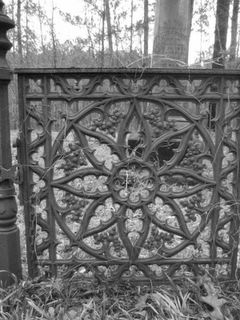
My next stop was St. Micheal's Church, which is Roman Catholic. This church- and the connected community- in fact is what drew me to Paulding. As you may imagine, rural Catholic churches, outside of Louisiana, are quite rare in the South. This one was brought by the presence of a considerable Irish immigrant community that settled in Paulding after fleeing the Potato Famine. Few and in between are rural Mississippi communities settled by Irish immigrants, at least from the 1800's. I know nothing else behind their history, but am sure there must be some stories there. St. Micheal's itself is the second oldest Catholic parish in the state, established in 1843 if I recall correctly. The adjoining cemetery is hauntingly beautiful, with two massive cedars and a fern-covered live oak. Two huge stands of bamboo border it- with the largest bamboo plants- trees almost- I have ever seen. Two simple statues- one of our Lord and the other of our Lady- preside over the grounds as well. Quite a few tombstones are of people who were born in Ireland- Counties Down, Meath, Limerick among others- and almost all are of Irish surnames. I hoped to find further information on the community and church's history in the church itself, but was disapointed. The church building itself fairly recent. I would like to return for Mass there sometime- at four o'clock on Saturdays, a sign indicated.
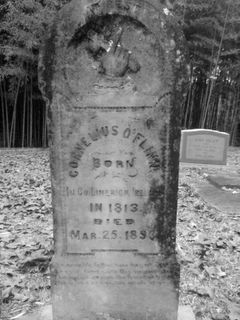
I had heard rumor of a Catholic monastery that once existed in Jasper County, near Paulding, and a web search confirmed it- it was a Cistercian house, founded in 1935 according to one Internet source; according to another it was in existence as early as the 1850's, which sounds more likely. I saw no sign or mention of it at the church, but a visit to the courthouse provided a little information. The courthouse, by the way, is fairly small, and terribly modern and utilitarian looking. It functions as an administrative center for the eastern part of the county; the county-seat proper has long since moved to Bay Springs, further west. The two ladies at the desk were very nice, but knew but little on the history of the place. They did provide me some information on the burning of the old courthouse, and told me where to find the monastery. Actually, where it used to be. Apparently it is no more; the buildings are now a hunting camp. I did not have time to search today- perhaps another time.
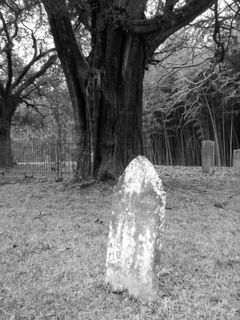
After St. Micheal's I went to the post office- post offices often being good places for information on little communities. The man at the counter was new there, but recommended I try the old postmaster. She had served for thiry-five years, and still lived next door. I walked across and knocked, but she wasn't at home. I hope to talk with her, as just looking at her yard indicated a great interest in local history: an old Paulding historical marker (yes, there's a new one across from the post office), various historical looking odds and ends and old outbuildings, and even a "See Historic Paulding" license plate (I don't think that project ever quite got off the ground!). But while walking down along the front of her yard, I noticed an old brick building across the little grassy track that seperates her yard from the post office. I walked over to it, and immediately knew its identity. Of all of old Paulding, only the jail, built in 1846, is still standing, and I found it, quite by accident. I had come across mention of it online, but had nearly forgotten about it.
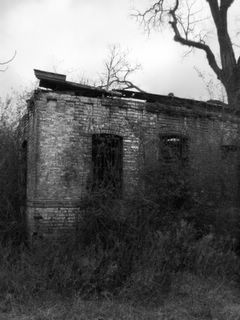
It is a fascinating place. The ceiling is all decayed, and one whole wall section is gone, but the iron cells are all still in place, as well as the windows and doors. It's in terrible disrepair, but then it's a marvel it's still standing, and not torn down and the metal hauled off for scrap. Privet surrounds it, and vines and fern are growing inside. There was a little graffiti on the main door, and a beer bottle or two, but otherwise no trash: just bits of the roof and walls littered the floor. It was a bit of an unerving place at first, with the heavy iron cage-like cells, decay, and thick privet all around: but a wonderful little gem (I doubt its former occupants ever felt that way!).
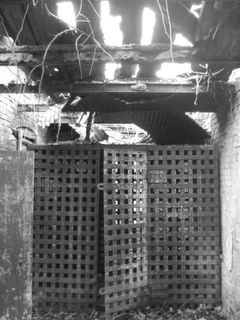
I knocked on a few other doors in town- most of them actually (and they weren't as ominous as the once above!)- but the only lady at home was a recent arrival to Paulding, and didn't know of its history at all. The bits and pieces I found have left me wanting to uncover more of the town's story, and the people who came there, lived, worshiped, and died there. The land is slowly eating up what remains, and time has a bad way of obscuring history. I hope to catch some before it all turns to ash and dust.











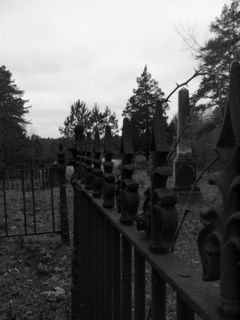

3 Comments:
Dear Jonathan Allen,
I've just run across your Manalive blog, as I was doing some web research on St. Michael's Catholic church in Paulding, MS.
The pictures you have uploaded to your blog from Paulding are
wonderful, and make me determined to visit this area in the future.
I'm very interested in the Irish colony that came to this part of
southeast MS in the mid-19th century, since it included some of my ancestors. My ancestors Valentine Ryan and Bridget Tobin came to Clarke Co., MS, by 1854, having landed in New Orleans in 1852. They came from Mullinavat in Co. Kilkenny, Ireland.
I think some ties to the Irish colony in Paudling have to have drawn them there. In 1856, Valentine and Bridget's oldest daughter Margaret married Robert Allen Sumrall in Clarke Co. Robert A. Sumrall's aunt
Mary had married an Irishman, Patrick Brogan, and this couple are buried in the St. Michael's cemetery at Paulding.
My Ryans left MS to buy farmland in Jefferson Co., AR, in 1859 and
are buried in Grant, a county formed out of Jefferson in 1870.
Thank you for the pictures on your website, and for the account of your trip to Paulding. I found it very well-written and instructive.
I feel like I have been there!
I was especially interested in the
St. Michael's Catholic Church and Cemetery. Thanks for sharing your trip.
I have many relatives including my father's father's father buried there last name is Bergin. thanks for the mention of the cemetery. My brother has been there. I hope one day so will I.
Post a Comment
<< Home